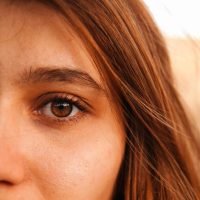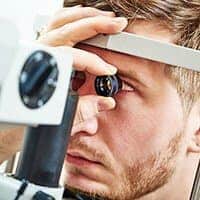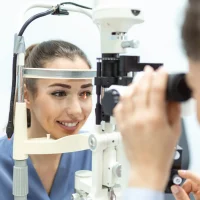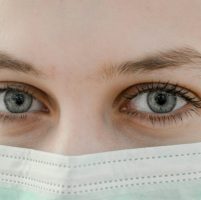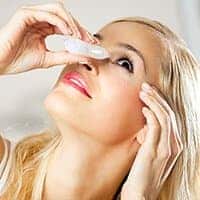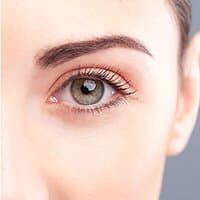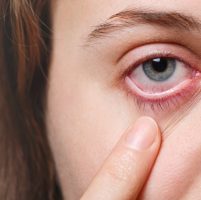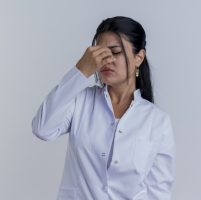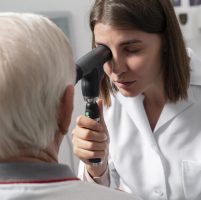Dry Eye
Around 48 percent of adult Americans have dry eye, which most often suggests that this may go undetected because the clinic generally sees people who are uncomfortable due to a condition-and can’t get into doing more intentional things in life. But we provide our patients with a specific treatment establishing eye sight and thus enhance their worth of life.
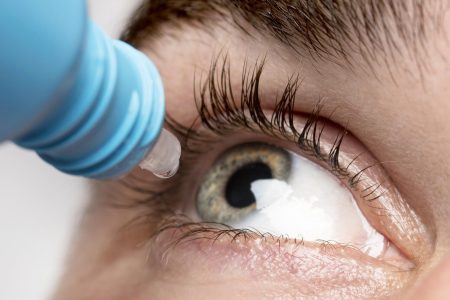
Dry Eye is what?
This takes place when the tears produced by the eyes are less in quantity than usual, or the balance of material in the tear film- water, oils, proteins-all supposed to lubricate the eyes is unbalanced. Which leads to dryness, irritation, and another form which is irritating to someone’s life.
Causes of Dry Eye
There can be anyone who gets dry eyes because of the following few potential causes.
Medications: like blood pressure drugs or antidepressants or a few others.
Disease present in the body-which are blepharitis, autoimmune disorders and Sjögren’s syndrome.
Lifestyle-such as computers used for longer durations and such little things as smoking and too much use of alcohol.
Environment: like air-conditioned workspace or living room.
Long-term use of contact lenses.
The effect of the person’s age on the eye, which often worsens the eye due to getting old; the older the person, the more suspicious.
Dry Eye Symptoms
In the beginning, the symptoms may be milder and less bothersome but as time passes, they become more severe, affecting daily life to a great extent. The complaint in most cases is some of less severity, like those itching or irritation:
The eyes become red, itching, and causes tearing .
One feels gritty material in the eye, as if something entered the eye.
Sometimes, the swelling of the eyes would occur, accompanied by redness and a bit of pain.
Vision gets hazy and distorted with difficulty in concentration.
Over-sensitivity to light is felt.
The Treatment of Dry Eye
Managing dry eye is easy owing to the plethora of treatment optons. Treatment usually depends on the individual’s preferences which is why we tend towards the most straightforward methods.
Eye Drops for Dry Eye Treatment
Over-the-counter solutions are the most effective in treating dry eye symptoms. Two of the most common options are Xiidra® and Restasis®.
Xiidra®: Only one prescription martini out there tackles the inflammation responsible for dry eyes; Xiidra®. It is the only FDA-approved treatment specifically designed for addressing dry eye symptoms. The regime is simple, just apply twice a day, during breakfast and 12 hours later. While some individuals struggle with mild discomfort and blurry vision upon use, it usually wears off plead within a few minutes and many users report feeling significant symptom improvement within two weeks of use.
Restasis®: An equally popular option is Restasis® which tackles chronic dry eye or eyeball dryness. It is particularly useful because it decreases inflammation while also increasing tear secretion. Some patients might report mild discomfort but it is not long-lived. Just as previously mentioned, this drug is perfect for users overwho stare wonderful glowing at a screen a battle at starring. Most patients report an increase tear production within a three month dry rest period.
Lipiflow treatment
Got dry eye? There’s a new treatment for that
Thirty million Americans suffer from Meibomian gland dysfunction, which causes the majority of dry eye cases. Learn how the LipiFlow® Thermal Pulsation System can help address it—in the blink of an eye.

Who doesn’t love fresh blooms, breezy weather, sunny skies—and burning eyes, if you have a condition known as dry eye, which can be exacerbated by the itching and tearing brought on by seasonal allergies.
What many longtime dry eye sufferers may not realize is that it’s often caused by Meibomian gland dysfunction (MGD), which occurs when the tiny Meibomian glands in eyelids become stopped up and unable to protect the tear film—a thin layer of fluid that covers the outer surface of the eye.
While MGD has traditionally been hard to treat, there’s a breakthrough therapy that’s making it far simpler to do: the LipiFlow® Thermal Pulsation System, which uses a cutting-edge device to heat up and massage away the blockage in just 12 minutes, right in your eye doctor’s office.
Never heard of MGD? Let us break it down for you
Although you may never have heard of this disorder, it’s actually quite common: More than 20 million Americans have dry eye. And according to one 2012 study published in the journal Cornea, 86% of study participants with dry eye also had symptoms of MGD.
The most likely culprit is poor blinking, explains Joe Boorady, OD, FAAO, Global Dry Eye Platform Leader, Johnson & Johnson Vision.
The science of blinking is downright fascinating: Every time we do so, we activate the muscles around our Meibomian glands, squeezing each one and causing the functional glands to secrete a droplet into the tear film.
“Those droplets fall into your tear film and create its lipid layer, or the outermost layer,” explains Dr. Boorady. “When you’re not blinking fully or frequently enough, the lipid layer stays stagnant, turning from a nice olive oil consistency to more of a thicker oil.” This blocks the gland, leading to the symptoms we classically associate with dry eye, such as burning and itching.
Why the future for dry eye sufferers looks bright
Historically, ophthalmologists and optometrists have had to try and clear blockages in the Meibomian glands by physically squeezing the eyelid—a sometimes painful and not-always-effective remedy.
But the LipiFlow system has helped change that.
And research just published in the journal Clinical Ophthalmology supports its effectiveness: The study showed that treatment with the device increased the average amount of time that contact lens wearers with MGD could comfortably wear their lenses by approximately four hours.
Curious to learn more about how it works? The procedure is done in just four simple steps:

1. First, your eye doctor will use the LipiScan imaging device to examine your Meibomian glands. This will help your doctor make a diagnosis, which may involve additional testing.
2. If it’s determined that you do have MGD, you can proceed with receiving the 12-minute LipiFlow treatment. Before it begins, your doctor will use numbing drops (the same ones routinely used at yearly eye exams) to help ease any potential discomfort from the procedure.
3. Next, the system’s activators—dome-shaped, single-use sterile devices—are placed on your eyes. Their vaulted shape keeps your corneas protected during the treatment, which focuses on the inner eyelids, where the Meibomian glands are located.
4. Using what’s called Vector Thermal Pulsation technology, the activators send heat into the glands inside your lids. This combination of heat plus pressure massages any blockages and liquefies and clears the obstructions that are causing your symptoms.
Studies show that while some patients experience some pain or discomfort from the procedure, the majority find it very tolerable.
“It was noninvasive, and I was able to just relax—it reminded me of being at a spa,” says Ashley McEvoy, Company Group Chairman, Johnson & Johnson Vision and Johnson & Johnson Diabetes Care Companies, who underwent LipiFlow herself.
And after it’s over? “You don’t have to worry about any impact to your vision—you can drive and do all your usual activities,” says Dr. Boorady.
Although many patients will see a change in symptoms right away, results generally optimize over six to eight weeks.
“I started to see improvement within three weeks and things continued to get better until I reached a new normal at about week six,” says McEvoy. “Since then, I have felt really good, with less eyestrain. I feel more comfortable, and my eyes feel less tired.”
Punctal Plugs
In cases where eye drops do not fully relieve your dry eye symptoms, your doctor may advise you try using tiny biocompatible devices called punctal plugs which are placed in the tear ducts to prevent drainage. There are two kinds of these plugs – one set that is slowly absorbed by the body and the other set that needs to be surgically removed. Insertion and removal of these plugs require local anesthesia but unlike other surgeries, there is no resting time needed after the procedure.
Manual Expression for Dry Eye Treatment
Manual meibomian gland expression is a therapeutic technique used to relieve dry eye caused by blocked oil glands in the eyelids. It involves gently applying pressure to the eyelids to express stagnant or thickened oil (meibum) from the meibomian glands, helping to restore a healthy tear film.
Procedure typically includes:
Application of a warm compress to soften gland secretions
Gentle pressure applied to the eyelids by a clinician using a sterile tool or finger
Removal of thickened oil to improve tear quality and reduce irritation
This treatment is often combined with eyelid hygiene, lubricating drops, or prescription medications for best results.
Lid Hygiene and Lid Scrubs
Maintaining proper eyelid hygiene is essential for managing dry eye, blepharitis, and meibomian gland dysfunction.
Lid hygiene involves regularly cleaning the eyelid margins to remove debris, oil buildup, and bacteria that can cause inflammation or clog the glands.
Lid scrubs are a common method and typically include:
Using a sterile, pre-moistened pad or diluted cleanser
Gently scrubbing along the lash line with eyes closed
Rinsing if directed, and drying the area with a clean towel
Frequency: Usually done once or twice daily, as recommended by your eye care provider.
Lid hygiene is a simple but effective step to improve comfort, reduce inflammation, and support long-term eye health.
OUR SERVICES
CATARACTS
Restore your vision and reclaim your life with our expert cataract services. Experience clearer sights with personalized care and advanced technology!
RETINA
Safeguard your vision with our advanced retina services. From diagnosis to treatment, we’re here to help protect and restore your sight!
DRY EYE
Find relief from dry eye discomfort with our comprehensive care solutions. Rejuvenate your eyes and restore comfort for clearer, brighter vision!
NEAR VISION
Enhance your near vision with our tailored solutions for reading and close-up tasks. Experience the joy of clear details and effortless focus!
GLAUCOMA
Stay ahead of glaucoma with our specialized screening and treatment options. Preserve your vision with early detection and expert care!
EYE DISEASE
Protect your vision with our expert eye disease management services. Early detection and personalized treatment can make all the difference—schedule your consultation today!
Hordeolum
Styes (hordeola) and chalazia are commonplace eyelid conditions that cause swelling but fluctuate in purpose and symptoms.
Blepharitis
Blepharitis influences extra than eighty two million humans within the United States, with many experiencing more than one episodes within the direction of their lifetime.
Catch on
Patient Portal
Stay connected to your care with our easy-to-use Patient Portal.
Find Our
EYE CARE CENTER
Visit our two state-of-the-art clinics in California, designed to best meet your needs.
Financial
ARRANGEMENT
Alta Vista Eye Care accepts a wide range of insurance plans and provides flexible patient financing options to assist with out-of-pocket expenses. Our dedicated financial counselors are here to guide you through the approval process, which takes just minutes!
What Our Clients Say
Trustindex verifies that the original source of the review is Google. I felt that the doctor was interested in me and was helpfulTrustindex verifies that the original source of the review is Google. Excellent service.Trustindex verifies that the original source of the review is Google. The staff and the doctor were the best.. very caring and knowledgeable. Excellent careTrustindex verifies that the original source of the review is Google. As always the service is perfect I love the staff and the doctor is awesomeTrustindex verifies that the original source of the review is Google. The doctors and staff at his office are exceptional in their field. After one trip to the emergency room, one trip to their office. Still feeling pain from what I believe before an object in my eye, they saw me at the end of their day. They all stayed late and a foreign object was removed from my eye.If you want, exceptional care, kindness, and highly educated doctors and staff. I would highly recommend this office to anybody looking for an ophthalmologist that is exceptional and an exceptional office staff I can’t thank them enough for the kindness and relief they’ve given meTrustindex verifies that the original source of the review is Google. Buen servicio muy buena atención y muy.buenos.especialista en la vista cataratas carnosidad glucomaTrustindex verifies that the original source of the review is Google. ExcellentTrustindex verifies that the original source of the review is Google. The Dr and his team members are very helpful and caring for their patients. I will recommend them to my friends and relatives. Thank you.
LOCATIONS
1901 Outlet Center Drive Suite 240
Oxnard, CA 93036
Tel 805-981-6300
1000 Newbury Road
Suite 230
Thousand Oaks, CA 91320
Tel 805-499-6800
